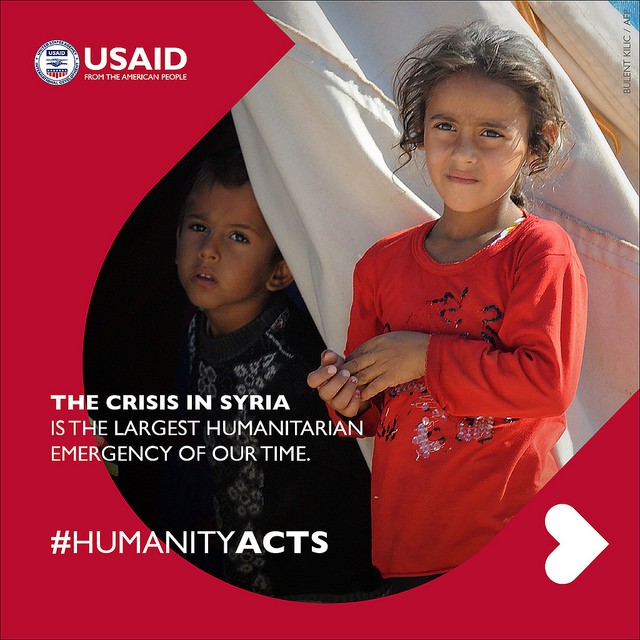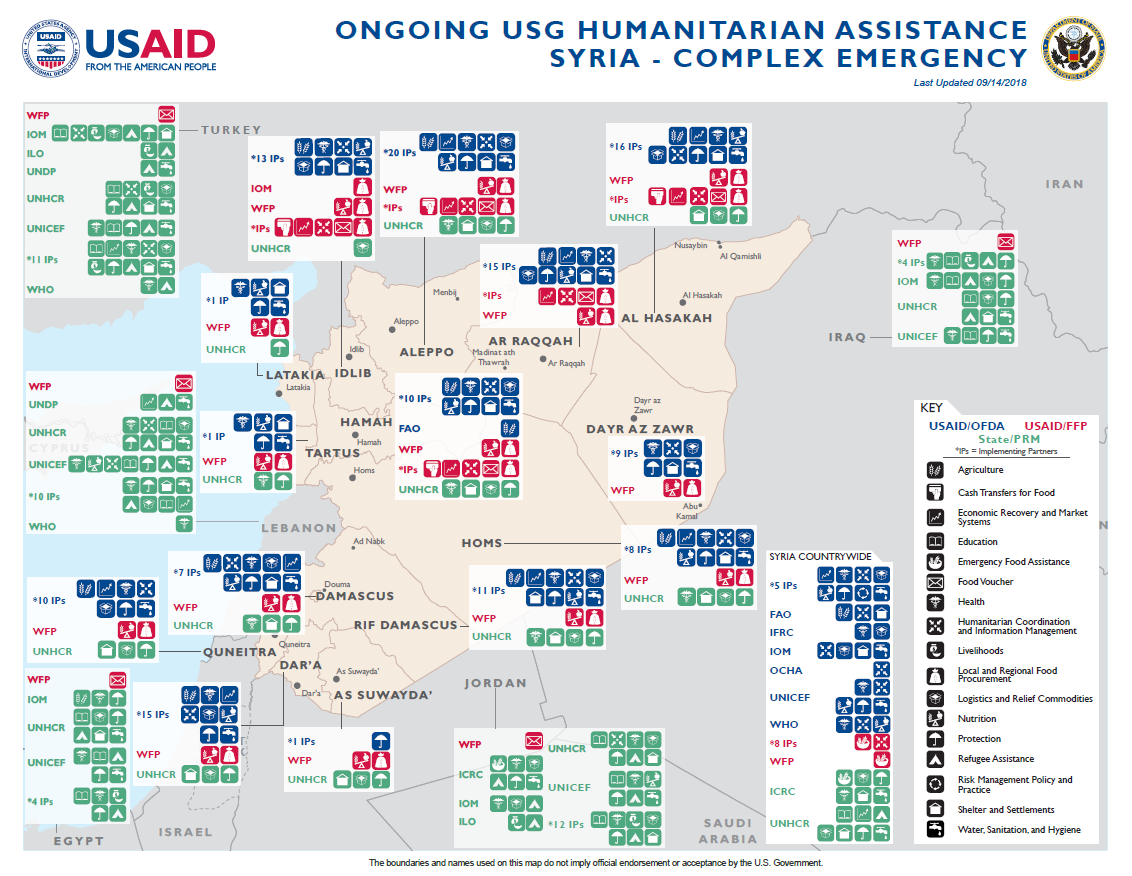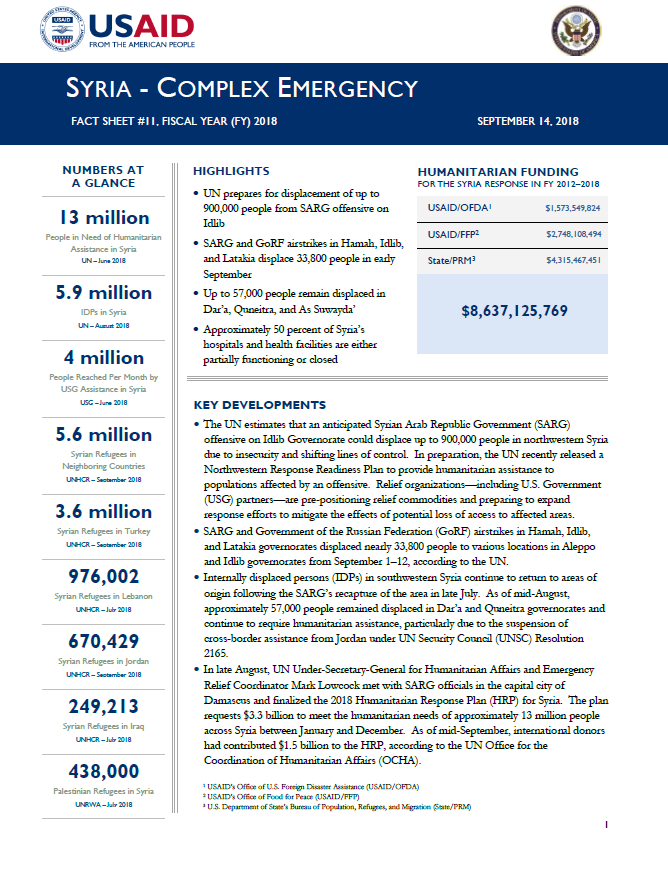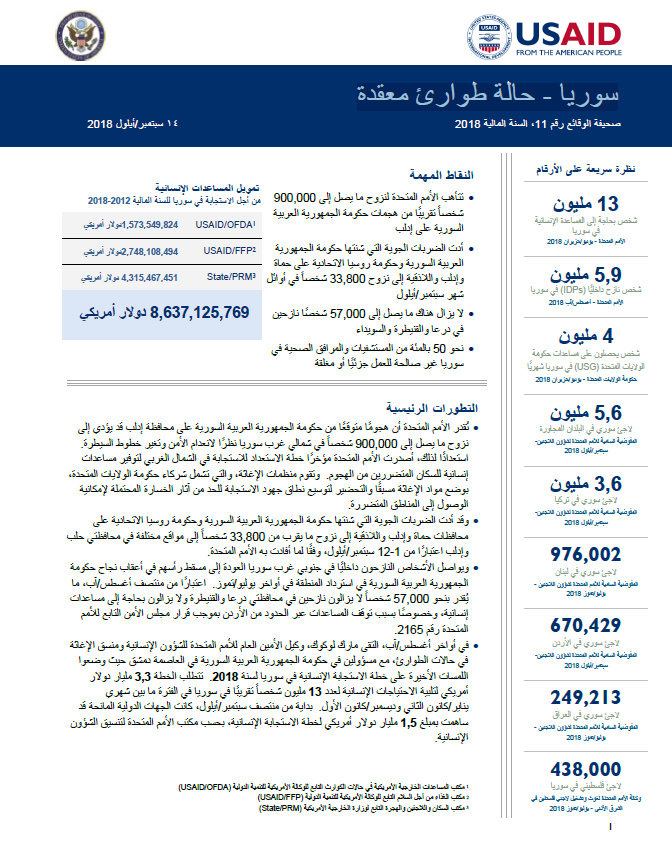- What We Do
- Agriculture and Food Security
- Democracy, Human Rights and Governance
- Economic Growth and Trade
- Education
- Environment and Global Climate Change
- Gender Equality and Women's Empowerment
- Global Health
- Humanitarian Assistance
- Transformation at USAID
- Water and Sanitation
- Working in Crises and Conflict
- U.S. Global Development Lab
Speeches Shim
September 14, 2018
Highlights
UN prepares for displacement of up to 900,000 people from SARG offensive on Idlib
SARG and GoRF airstrikes in Hamah, Idlib, and Latakia displace 33,800 people in early September
Up to 57,000 people remain displaced in Dar’a, Quneitra, and As Suwayda’
Approximately 50 percent of Syria’s hospitals and health facilities are either partially functioning or closed
Key Developments
The UN estimates that an anticipated Syrian Arab Republic Government (SARG) offensive on Idlib Governorate could displace up to 900,000 people in northwestern Syria due to insecurity and shifting lines of control. In preparation, the UN recently released a Northwestern Response Readiness Plan to provide humanitarian assistance to populations affected by an offensive. Relief organizations—including U.S. Government (USG) partners—are pre-positioning relief commodities and preparing to expand response efforts to mitigate the effects of potential loss of access to affected areas.
SARG and Government of the Russian Federation (GoRF) airstrikes in Hamah, Idlib, and Latakia governorates displaced nearly 33,800 people to various locations in Aleppo and Idlib governorates from September 1–12, according to the UN.
Internally displaced persons (IDPs) in southwestern Syria continue to return to areas of origin following the SARG’s recapture of the area in late July. As of mid-August, approximately 57,000 people remained displaced in Dar’a and Quneitra governorates and continue to require humanitarian assistance, particularly due to the suspension of cross-border assistance from Jordan under UN Security Council (UNSC) Resolution 2165.
In late August, UN Under-Secretary-General for Humanitarian Affairs and Emergency Relief Coordinator Mark Lowcock met with SARG officials in the capital city of Damascus and finalized the 2018 Humanitarian Response Plan (HRP) for Syria. The plan requests $3.3 billion to meet the humanitarian needs of approximately 13 million people across Syria between January and December. As of mid-September, international donors had contributed $1.5 billion to the HRP, according to the UN Office for the Coordination of Humanitarian Affairs (OCHA).
Syria Complex Emergency - Map #11 FY18 ![]() (pdf - 462k)
(pdf - 462k)
Numbers At A Glance
13 million
5.9 million
4 million
5.6 million
3.6 million
976,002
670,429
249,213
438,000
Humanitarian Funding
To Syria Humanitarian Response
FY 2012 - FY 2018
| USAID/OFDA | $1,573,549,824 |
| USAID/FFP | $2,748,108,494 |
| State/PRM | $4,315,467,451 |
| TOTAL | $8,637,125,769 |
Syria Complex Emergency - Fact Sheet #11 FY18 ![]() (pdf - 341k)
(pdf - 341k)
سوريا حالة طوارئ معقدة ![]() (pdf - 786k)
(pdf - 786k)
INSECURITY, DISPLACEMENT, AND HUMANITARIAN ACCESS
Insecurity and bureaucratic impediments—such as lack of SARG authorization, delayed facilitation letters, and limitations on quantities and types of supplies—continue to hinder humanitarian organizations providing assistance to vulnerable populations, including the approximately 1.5 million people who were residing in UN-identified hard-to-reach areas as of late July, the UN reports. In addition, border closures and restrictions, explosive remnants of war contamination, intensified conflict, and interference from armed opposition groups (AOGs) prevent relief agencies from accessing affected areas. As a result, humanitarian organizations reached only 13 percent of people in need residing in besieged and hard-to-reach areas from January–June, according to the UN.
Conflict in Syria killed at least 391 civilians during August, contributing to a total of 6,036 civilian deaths since the start of 2018, according to the Syrian Network for Human Rights (SNHR). SARG and GoRF military operations killed 4,419 people during that time period, SNHR reports. The number of civilians killed in August represents nearly a 55 percent decrease from July, when 866 civilians were killed, due to a reduction in military operations in Syria.
Central and Southern Syria
Displaced populations continue to return to areas of origin in Dar’a and Quneitra following the SARG’s recapture of southwestern Syria in late July. From August 1–16, the number of IDPs in the region decreased from approximately 184,000 to 57,000 people, the UN reports.
Returnees and IDPs remain in need of humanitarian assistance, particularly due to the suspension of cross-border assistance from Jordan. On August 9, the Syrian Arab Red Crescent (SARC) delivered hygiene kits and other relief commodities to nearly 32,500 people in Dar’a city, while a UN and SARC interagency team delivered health, nutrition, and water, sanitation, and hygiene (WASH) assistance to 7,500 people and conducted a rapid needs assessment in Dar’a’s Busra al-Sham town on August 16. However, relief agencies continue to experience access constraints that hinder efforts to deliver humanitarian assistance to vulnerable populations and conduct needs assessments in southwestern Syria. Humanitarian organizations lack information on humanitarian needs in Quneitra because the SARG has not permitted UN agencies the sustained access required to conduct detailed needs assessments.
The conflict caused significant infrastructure damage in several towns and villages in southern Syria, which has affected livelihoods opportunities, particularly in the agricultural sector, according to the UN. Despite the re-opening of markets in some areas of southern Syria, many displaced and returnee populations lack sufficient income to purchase food. Insecurity in certain areas also prevents relief organizations from accessing vulnerable populations to distribute food, the UN reports. In addition, lack of civil documentation, SARG security procedures, and prohibitive transportation costs have hindered civilian population movement. Relief agencies also report significant unexploded ordnance contamination, especially in Dar’a’s Yarmouk Basin and surrounding areas, according to the UN.
Northwestern Syria
Approximately 3 million people reside in Idlib’s de-escalation zone—one of four de-escalation zones established in August 2017 by the Government of Iran, the GoRF, and the Government of Turkey (GoT), comprising areas of Aleppo, Hamah, Idlib, and Latakia. Approximately 2.1 million people in the zone are currently in need of humanitarian assistance, including 1.4 million people who are displaced, the UN reports.
In preparation for an anticipated SARG offensive on Idlib, the UN recently released a Northwestern Response Readiness Plan, aiming to provide humanitarian assistance to approximately 900,000 people in northwestern Syria—including Idlib, western Aleppo, northern Hamah, and eastern Latakia, as well as Aleppo’s Tell Refaat sub-district and Fafin town—that may be displaced due to insecurity and shifting lines of control. The plan consists of two components: a response plan for humanitarian organizations based in Turkey to access Syria cross-border, which requires security and access guarantees and GoT approval for humanitarian organizations to operate in GoT-controlled areas, and a plan for humanitarian organizations to access people in need from within Syria, which requires SARG approval of humanitarian deliveries.
According to the Response Plan, the offensive may displace up to 800,000 people to GoT- and SARG-controlled areas in Idlib, northern Hamah, and southern Aleppo, as well as up to 100,000 people to Aleppo’s Nabul and Zahra towns,
including potentially small numbers of IDPs to northeastern Syria. The UN estimates that $311 million in funding is required to provide life-saving assistance—including emergency relief commodities, food, health care and protection services, shelter, and WASH activities—to populations affected by an Idlib offensive. Relief organizations—including USG partners—are preparing to scale up response efforts and are pre-positioning relief commodities.
From September 1–12, SARG and GoRF airstrikes in northern Hamah, southern Idlib, and Latakia displaced nearly 33,800 people to areas in northern and northwestern Idlib and Aleppo’s Afrin District, according to the UN. As of September 9, approximately 47 percent of displaced households had relocated to camps, 29 percent were staying with family members, 14 percent were residing in informal settlements, and 10 percent were in rented accommodation. The UN notes that numbers and locations of IDPs may fluctuate, as the situation remains fluid. In addition, airstrikes prompted the closure of several non-governmental organization (NGO)-supported hospitals in affected areas. On September 6, an NGO-supported hospital in Hamah’s Kafr Zeita sub-district—which provides an average of 780 medical consultations and 200 trauma case treatments monthly—suspended operations after an alleged airstrike caused significant structural damage, according to the UN. Reported aerial bombardments and strikes on September 8 also prompted the closure of NGO-supported hospitals in southern Idlib’s Hass town and northern Hamah’s Latmana town.
Due to concern regarding a potential military offensive in Idlib, the REACH Initiative conducted an August assessment of more than half of the 700 AOG-controlled communities in areas of Aleppo, Hamah, and Idlib to identify information gaps and inform humanitarian response efforts. According to the assessment, residents in Idlib and surrounding areas are primarily concerned about safety and increased protection risks, including threats from aerial bombardment, early marriage, kidnapping, and movement restrictions. Approximately 50 percent of assessed communities reported shelter as a priority need, particularly for IDPs, up to 80 percent of whom were residing in overcrowded shelters. In addition, more than 60 percent of assessed communities reported utilizing negative coping strategies—including reducing meal size, selling productive assets, and skipping meals—to meet food needs due to lack of income, and more than 90 percent reported facing barriers to accessing health care services, including lack of available health facilities, few female doctors, and shortages of medical personnel and supplies.
HEALTH AND WASH
Approximately 50 percent of Syria’s 111 public hospitals and more than 50 percent of the country’s 1,800 primary health care centers are either partially functioning or closed, the Health Cluster reported in mid-August. Health care staff shortages, increasing communicable disease transmission, and limited WASH services continue to challenge emergency health response efforts in Syria.
In preparation for an anticipated Idlib offensive, the UN Children’s Fund (UNICEF) has pre-positioned WASH supplies, including hygiene kits, water purification materials, and water storage items, for approximately 200,000 people in Idlib, the organization reports. In addition, USG partner the UN World Health Organization (WHO) dispatched more than 25 tons of medical supplies to Aleppo in August and plans to expand the nine WHO-supported NGO mobile health teams and three health facilities providing health care services in northwestern Syria.
From mid-June to mid-August, WHO provided life-saving health care services for more than 900,000 people in southern Syria. During the period, the UN agency delivered more than 60 metric tons of medical supplies—including burn, surgical, and trauma kits and medicines sufficient for more than 312,000 treatments—to Dar’a, Quneitra, and As Suwayda’ governorates. WHO is also supporting the only functioning blood bank in areas of southern Syria previously controlled by AOGs.
In Dar’a and Quneitra, WHO-supported health organizations are providing health care and nutrition services through static medical points and mobile clinics. Since mid-June, health agencies in Dar’a have provided more than 19,000 consultations, while organizations in Quneitra have provided more than 2,500 consultations―primarily through mobile teams―to IDPs sheltering in makeshift camps. WHO has also supported the referral of more than 360 critically injured patients in southern Syria to hospitals in Dar’a and Damascus cities for further treatment. In addition, WHO-supported relief organizations have screened more than 15,000 children in Dar’a and Quneitra for acute malnutrition.
FOOD SECURITY AND NUTRITION
As of August 31, more than 6.7 million people in Syria were food insecure, with an additional 4.5 million people at risk of experiencing food insecurity, according to USAID/FFP partner the UN World Food Program (WFP). In response to food needs, WFP delivered emergency food assistance to more than 2.9 million people throughout Syria during August. In addition, the UN agency reports it delivered emergency food assistance to an estimated 665,000 people across Syria from September 1–6.
In preparation for a SARG military offensive on Idlib, WFP had pre-positioned ready-to-eat food rations sufficient to feed approximately 850,000 people for one week as of September 7. In addition, WFP has sufficient nutrition supplies to support 180,000 women and children in Idlib for up to three months, with the capacity to provide additional supplies as needed.
Of the nearly 4,130 children ages five years and younger screened for malnutrition in Dar’a, Quneitra, and As Suwayda’ from August 1–14, humanitarian agencies identified and treated more than 80 children experiencing moderate acute malnutrition (MAM) and 20 children experiencing severe acute malnutrition (SAM), according to the UN. Overall, approximately 65,500 and 18,700 children were experiencing MAM and SAM, respectively, as of early August, WFP reports.
REFUGEE ASSISTANCE
State/PRM partner the Office of the UN High Commissioner for Refugees (UNHCR) reached 27,000 Syrian refugee households in Jordan through $28 million in multi-purpose cash assistance from January–June. UNHCR reports that more than 80 percent of households utilized the cash assistance for rent, while food, health, and utility costs were other common expenditures. Many beneficiary households noted the assistance was insufficient to meet all needs, particularly health care services. Cash assistance was the sole source of income for more than 20 percent of participating refugees. UNHCR also monitors the impact of cash programming on protection conditions, with nearly 100 percent of beneficiaries reporting no intra-household disagreements on the use of cash assistance.
From January–July, relief organizations recorded approximately 810 confirmed measles cases—22 percent of which were among Syrian refugees—in Lebanon, according to the UN. State/PRM partner UNICEF and the Government of Lebanon Ministry of Public Health are expanding immunization efforts to control the outbreak, vaccinating nearly 47,600 children in 2018. With State/PRM support, UNICEF had also provided emergency WASH supplies to approximately 182,000 Syrian refugees living in informal settlements in Lebanon as of August.
PUBLIC DONATION INFORMATION
The most effective way people can assist relief efforts is by making cash contributions to humanitarian organizations that are conducting relief operations. A list of humanitarian organizations that are accepting cash donations for disaster responses around the world can be found at www.usaid.gov/crisis/syria.
The USG encourages cash donations because they allow aid professionals to procure the exact items needed (often in the affected region); reduce the burden on scarce resources (such as transportation routes, staff time, and warehouse space); can be transferred very quickly and without transportation costs; support the economy of the disaster-stricken region; and ensure culturally, dietary, and environmentally appropriate assistance.





Comment
Make a general inquiry or suggest an improvement.